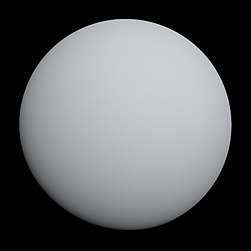WASP-79b
| Exoplanet | List of exoplanets | |
|---|---|---|
| Parent star | ||
| Star | WASP-79 | |
| Constellation | Eridanus[1] | |
| Right ascension | (α) | 04h 25m 29.0168s[2] |
| Declination | (δ) | −30° 36′ 01.6110″[2] |
| Apparent magnitude | (mV) | 10.1[3] |
| Distance | 810±6[2] ly (248±2[2] pc) | |
| Spectral type | F3[3] | |
| Mass | (m) | 1.38±0.12[3] M☉ |
| Radius | (r) | 1.53±0.31[3] R☉ |
| Temperature | (T) | 6600±100[3] K |
| Orbital elements | ||
| Semi-major axis | (a) | 0.0535±0.0008[3] AU |
| Eccentricity | (e) | 0[3] |
| Orbital period | (P) | 3.662366±0.0000085[3] d |
| Inclination | (i) | 83.3±0.5°[3]° |
| Physical characteristics | ||
| Mass | (m) | 0.90±0.08[3] MJ |
| Radius | (r) | 2.09±0.14[3] RJ |
| Temperature | (T) | 1900±50[3] K |
| Discovery information | ||
| Discovery date | June 1 2012[3] | |
| Discoverer(s) | Smalley et al.[3] | |
| Discovery method | Transit method[3] | |
| Discovery status | Published[3] | |
| Other designations | ||
WASP-79 b, 1SWASP J042529.01-303601.5 b, 2MASS J04252901-3036016 b, CD-30 1812 b, GSC 07038-00834 b, SAO 195000 b, TYC 7038-00834-1 b, WISE J042529.01-303601.5 b | ||
| Database references | ||
| Extrasolar Planets Encyclopaedia | data | |
| SIMBAD | data | |
| Exoplanet Archive | data | |
| Open Exoplanet Catalogue | data | |
WASP-79b is an extrasolar planet orbiting the star CD-30 1812. This planet is in the constellation Eridanus, and is about 810 light-years from Earth.
Host star
WASP-79, or CD-30 1812, is a F-type dwarf star located at 240 parsecs (810 light years) away from Earth. With 1.38 M☉ and 1.53 R☉, it is both larger and more massive than the Sun. Its effective temperature is 6,600 K, making it hotter than the Sun.[3]
Characteristics
WASP-79b is a very large hot jupiter that is among the largest exoplanets discovered although its size is uncertain. It is most likely to be larger at 2.09 ± 0.14 RJ (approximately 300,000 kilometers across) with a temperature of 1,900 ± 50 K. However, it could be as small as 1.7 ± 0.11 RJ (approximately 240,000 kilometers across), which is comparable to the size of another hot jupiter WASP-78b, with a temperature at 1,770 ± 50 K. Even if bigger than Jupiter, its mass is slightly less massive than Jupiter.[3]
| Jupiter | WASP-79b |
|---|---|
 |
 |
See also
References
- ↑ Roman, Nancy G. (1987). "Identification of a Constellation From a Position". Publications of the Astronomical Society of the Pacific. 99 (617): 695–699. Bibcode:1987PASP...99..695R. doi:10.1086/132034. Vizier query form
- 1 2 3 4 Brown, A. G. A.; et al. (Gaia collaboration) (August 2018). "Gaia Data Release 2: Summary of the contents and survey properties". Astronomy & Astrophysics. 616. A1. arXiv:1804.09365. Bibcode:2018A&A...616A...1G. doi:10.1051/0004-6361/201833051. Gaia DR2 record for this source at VizieR.
- 1 2 3 4 5 6 7 8 9 10 11 12 13 14 15 16 17 18 Smalley, B; Anderson, D. R; Collier-Cameron, A; Doyle, A. P; Fumel, A; Gillon, M; Hellier, C; Jehin, E; Lendl, M; Maxted, P. F. L; Pepe, F; Pollacco, D; Queloz, D; Ségransan, D; Smith, A. M. S; Southworth, J; Triaud, A. H. M. J; Udry, S; West, R. G (2012). "WASP-78b and WASP-79b: Two highly-bloated hot Jupiter-mass exoplanets orbiting F-type stars in Eridanus". Astronomy & Astrophysics. 547: A61. arXiv:1206.1177. Bibcode:2012A&A...547A..61S. doi:10.1051/0004-6361/201219731.